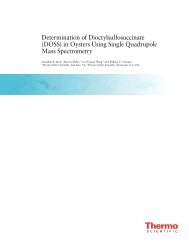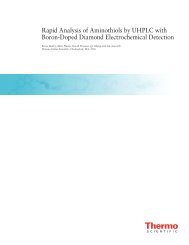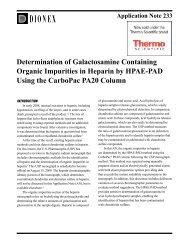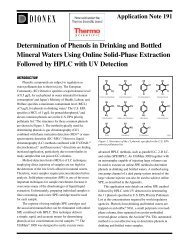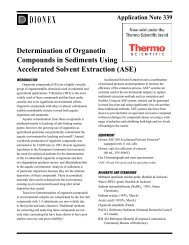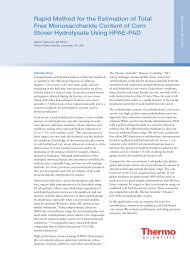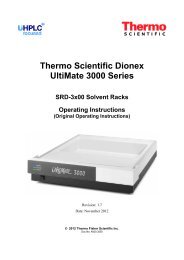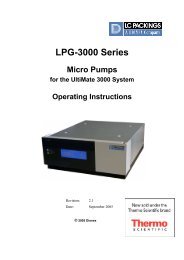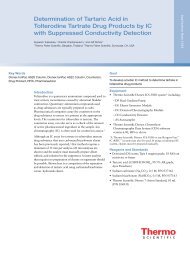Determination of Succinic, Glutaric, and Adipic Acids as ... - Dionex
Determination of Succinic, Glutaric, and Adipic Acids as ... - Dionex
Determination of Succinic, Glutaric, and Adipic Acids as ... - Dionex
Create successful ePaper yourself
Turn your PDF publications into a flip-book with our unique Google optimized e-Paper software.
Application Note 285<br />
<strong>Determination</strong> <strong>of</strong> <strong>Succinic</strong>, <strong>Glutaric</strong>, <strong>and</strong><br />
<strong>Adipic</strong> <strong>Acids</strong> <strong>as</strong> Quality Control <strong>of</strong><br />
Cyclohexanone Production<br />
INTRODUCTION<br />
Cyclohexanone is the key intermediate for the<br />
production <strong>of</strong> adipic acid, an important compound for<br />
the synthesis <strong>of</strong> nylon 66. 1 Cyclohexane oxidation is the<br />
normal method for the production <strong>of</strong> cyclohexanone; <strong>and</strong><br />
succinic, glutaric, <strong>and</strong> adipic acids (structures shown in<br />
Figure 1), <strong>as</strong> well <strong>as</strong> their dehydration products, are the<br />
main by-products. 2 The three aliphatic dicarboxylic acids<br />
are important chemical raw materials <strong>as</strong> well, <strong>and</strong> their<br />
determination is important for the quality control <strong>of</strong><br />
cyclohexanone production <strong>and</strong> recycling <strong>of</strong> the by-products.<br />
O O O<br />
O<br />
HO<br />
OH<br />
HO<br />
OH<br />
HO<br />
OH<br />
O<br />
O<br />
<strong>Succinic</strong> Acid <strong>Glutaric</strong> Acid <strong>Adipic</strong> Acid<br />
Figure 1. Structures <strong>of</strong> succinic, glutaric, <strong>and</strong> adipic acids.<br />
28855<br />
It is difficult to use potentiometric titration to<br />
determine succinic, glutaric, <strong>and</strong> adipic acids due to<br />
their similar ionization constants. 3 To determine these<br />
compounds by g<strong>as</strong> chromatography (GC), precolumn<br />
derivatization—esterification with alcohols—is required<br />
because <strong>of</strong> their strong polarity <strong>and</strong> high boiling point. 4<br />
This is a time-consuming <strong>and</strong> complicated operation,<br />
resulting in poor reproducibility <strong>of</strong> the esterification rate.<br />
Therefore, the determination <strong>of</strong> succinic, glutaric, <strong>and</strong><br />
adipic acids is usually performed by ion chromatography<br />
(IC) 5-7 <strong>and</strong> reversed-ph<strong>as</strong>e high-performance liquid<br />
chromatography (RP-HPLC). 8,9 Because the three<br />
aliphatic dicarboxylic acids lack a good ultraviolet (UV)<br />
chromophore, m<strong>as</strong>s spectrometry (MS) is used to achieve<br />
sensitive detection. 10,11<br />
The work shown here describes an LC-MS method<br />
for the determination <strong>of</strong> succinic, glutaric, <strong>and</strong> adipic<br />
acids in the by-products <strong>of</strong> cyclohexanone production.<br />
The separation is performed on a Thermo Scientific<br />
Acclaim Organic Acid (OA) column, which is designed<br />
for the separation <strong>of</strong> organic acids. 12,13 B<strong>as</strong>eline separation<br />
<strong>of</strong> these three aliphatic dicarboxylic acids is observed<br />
with resolutions (Rs) ≥ 2.6 <strong>and</strong> completed within 10 min.<br />
Analytes are detected by electrospray ionization (ESI) on<br />
a Thermo Scientific MSQ Plus m<strong>as</strong>s detector operated in<br />
the negative ion mode by full scan MS. The m<strong>as</strong>s spectra<br />
<strong>of</strong> the peaks eluting at approximately 1.8, 2.5, <strong>and</strong> 4.5 min<br />
reveals the deprotonated molecular ions [M-H]- at m/z<br />
116.9, m/z 130.9, <strong>and</strong> m/z 144.9 for succinic, glutaric, <strong>and</strong><br />
adipic acids, respectively.
Ions with m<strong>as</strong>ses <strong>of</strong> m/z 72.9, m/z 86.9, <strong>and</strong> m/z 100.9 are<br />
characteristic fragment ions caused by in-source collision<br />
induced dissociation (CID) <strong>and</strong> correspond to the loss <strong>of</strong><br />
one carboxyl group using a cone voltage setting <strong>of</strong> 60 V.<br />
Quantification is accomplished via selected ion<br />
monitoring (SIM) using ions corresponding to each <strong>of</strong> the<br />
dicarboxylic acids at m/z 117 for succinic acid, m/z 131<br />
for glutaric acid, <strong>and</strong> m/z 145 for adipic acid. Excellent<br />
linearity within 0.1 to 5 mg/L is observed for each<br />
dicarboxylic acid, <strong>and</strong> method detection limits (MDL)<br />
are all ≤ 0.06 mg/L.<br />
EQUIPMENT<br />
Thermo Scientific <strong>Dionex</strong> UltiMate 3000 RSLC<br />
system including:<br />
SR-3000 without Deg<strong>as</strong>ser<br />
LPG-3400RS Pump<br />
WPS-3000TRS Autosampler<br />
TCC-3000RS Thermostatted Column Compartment<br />
DAD-3000RS UV-vis Detector<br />
MSQ Plus m<strong>as</strong>s detector with ESI source<br />
Thermo Scientific <strong>Dionex</strong> AXP-MS Pump<br />
Thermo Scientific <strong>Dionex</strong> Chromeleon Chromatography<br />
Data System (CDS) s<strong>of</strong>tware, Version 6.80, SR9 or higher<br />
REAGENTS AND STANDARDS<br />
Deionized (DI) water, from Milli-Q ® Gradient A10<br />
Acetonitrile (CH CN), HPLC grade<br />
3<br />
(Cat.#AC610010040), Fisher Chemical<br />
Formic acid (FA), HPLC grade, SCRC, Shanghai, China<br />
<strong>Succinic</strong>, glutaric, <strong>and</strong> adipic acids (analytical grade)<br />
were purch<strong>as</strong>ed from SCRC, Shanghai, China.<br />
Prepare stock st<strong>and</strong>ard solutions with concentration<br />
<strong>of</strong> 1000 mg/L for each aliphatic dicarboxylic acid by<br />
dissolving the appropriate amount <strong>of</strong> st<strong>and</strong>ards in DI<br />
water. Prepare four working st<strong>and</strong>ard solutions ranging<br />
from 0.1 to 5.0 mg/L for the calibration by adding the<br />
appropriate amount <strong>of</strong> the stock st<strong>and</strong>ard solution <strong>and</strong><br />
diluting with DI water.<br />
SAMPLE PREPARATION<br />
Three sample solutions <strong>of</strong> mixed dib<strong>as</strong>ic acids<br />
(#1, #2, <strong>and</strong> #3) generated from cyclohexane production<br />
were kindly donated by a customer located in Jiangsu<br />
Province, China.<br />
Make thous<strong>and</strong>-fold dilutions with DI water <strong>and</strong><br />
filter through a 0.45 μm membrane (Millex ® -LH) prior<br />
to injection.<br />
CHROMATOGRAPHIC CONDITIONS<br />
Analytical Column: Acclaim OA, 3 μm,<br />
2.1 × 150 mm (P/N 070087)<br />
Mobile Ph<strong>as</strong>e: A: 0.1% FA aqueous (v/v)<br />
B: CH CN 3<br />
In gradient<br />
-5.0–0.0 min, 5% B,<br />
0.0–5.0 min, 5–40% B<br />
Flow Rate: 0.3 mL/min<br />
Inj. Volume: 10 μL<br />
Column Temp.: 30 °C<br />
MSQ-Plus M<strong>as</strong>s Detector Conditions<br />
Ionization Interface: ESI<br />
Operating Mode: Negative Scan<br />
Scan Events: Full scan for identification:<br />
65–150 m/z<br />
SIM scan for quantitation: succinic<br />
acid: 117 m/z; glutaric acid: 131 m/z;<br />
adipic acid: 145 m/z<br />
Probe Temp.: 400 °C<br />
Needle Voltage: 3.5 KV<br />
Cone Voltage: 60 V<br />
Nebulizer G<strong>as</strong>: Nitrogen at 75 psi<br />
2 <strong>Determination</strong> <strong>of</strong> <strong>Succinic</strong>, <strong>Glutaric</strong>, <strong>and</strong> <strong>Adipic</strong> <strong>Acids</strong> <strong>as</strong> Quality Control <strong>of</strong> Cyclohexanone Production
RESULTS AND DISCUSSION<br />
Separation <strong>of</strong> <strong>Succinic</strong>, <strong>Glutaric</strong>, <strong>and</strong> <strong>Adipic</strong> <strong>Acids</strong> on the<br />
Acclaim OA Column<br />
Formic acid w<strong>as</strong> used in place <strong>of</strong> sulfate or phosphate<br />
in order to develop an MS-compatible method with<br />
comparable performance to typical ionic mobile ph<strong>as</strong>es.<br />
Figure 2 shows the chromatograms <strong>of</strong> a mixed st<strong>and</strong>ards<br />
solution <strong>and</strong> an undiluted sample solution separated on the<br />
Acclaim OA column under the specified chromatographic<br />
conditions with UV detection. <strong>Succinic</strong>, glutaric, <strong>and</strong><br />
adipic acids were separated with good resolution, <strong>and</strong><br />
two unknown peaks with similar UV spectra to the three<br />
dicarboxylic acids (Figure 3) were found in the sample<br />
solution. The purity <strong>of</strong> these peaks may be estimated using<br />
the peak purity match factor, which can be calculated by<br />
Chromeleon CDS s<strong>of</strong>tware. The calculated values are 999<br />
for succinic, 1000 for glutaric, 998 for adipic acids, 994<br />
for unknown peak 1, <strong>and</strong> 997 for unknown peak 2<br />
(the corresponding value for 100% purity is 1000).<br />
These results demonstrate that the Acclaim OA column<br />
provides good selectivity <strong>and</strong> is suitable for the<br />
determination <strong>of</strong> succinic, glutaric, <strong>and</strong> adipic acids in<br />
these sample solutions.<br />
Further experimentation showed that the two<br />
unknown compounds with UV absorption showed no MS<br />
response. Efforts to ionize <strong>and</strong> detect the unknowns by<br />
MS (i.e., enlargement <strong>of</strong> scan range from 50 to 800 amu,<br />
application <strong>of</strong> different cone voltages between 20 <strong>and</strong><br />
100 V, use <strong>of</strong> atmospheric-pressure chemical ionization<br />
[APCI] <strong>and</strong> ESI sources in negative <strong>and</strong> positive ion<br />
modes, <strong>and</strong> use <strong>of</strong> mobile ph<strong>as</strong>es with different pH<br />
values) were unsuccessful. Because the unknowns were<br />
generated during cyclohexane oxidation, they may be<br />
dehydration products <strong>of</strong> the three dicarboxylic acids 2<br />
<strong>and</strong>/or other degradants <strong>of</strong> cyclohexanone.<br />
mAU<br />
150<br />
Column: Acclaim OA (2.1 × 150 mm, 3 µm)<br />
Mobile Ph<strong>as</strong>e: Acetonitrile/0.1% formic acid (v/v),<br />
in gradient: acetonitrile, -5.0–0.0 min, 5%; 5.0 min, 40%<br />
Flow Rate: 0.3 mL/min<br />
Inj. Volume: 10 µL<br />
Column Temp.: 30 °C<br />
Detection: UV, 210 nm<br />
Chromatogram: a: An undiluted sample solution<br />
b: A mixed st<strong>and</strong>ards solution<br />
(1000 mg/L for each dicarboxylic acid)<br />
Peak: 1. <strong>Succinic</strong> acid<br />
2. <strong>Glutaric</strong> acid<br />
3. <strong>Adipic</strong> acid<br />
4. Unknown compound 1<br />
5. Unknown compound 2<br />
0<br />
b<br />
a<br />
1<br />
1<br />
-150<br />
0 0.5 1 1.5 2 2.5<br />
Minutes<br />
3 3.5 4 4.5 5<br />
Figure 2. Chromatograms <strong>of</strong> (a) an undiluted sample solution <strong>and</strong><br />
(b) a mixed st<strong>and</strong>ards solution (1000 mg/L for each dicarboxylic acid).<br />
60<br />
%<br />
204.0<br />
Figure 3. UV spectra <strong>of</strong> (A) succinic acid, (B) glutaric acid,<br />
(C) adipic acid, (D) unknown compound 1, <strong>and</strong> (E) unknown<br />
compound 2.<br />
4<br />
2<br />
2<br />
28856<br />
Application Note 285 3<br />
3<br />
5<br />
3<br />
60<br />
60<br />
206.4<br />
A B<br />
206.0<br />
C<br />
%<br />
-10<br />
-10<br />
-10<br />
200 375<br />
nm<br />
500 200 375<br />
nm<br />
500 200 375<br />
nm<br />
500<br />
60<br />
%<br />
208.7<br />
275.6 471.8<br />
-10<br />
200 375<br />
nm<br />
500<br />
%<br />
60<br />
D<br />
207.5<br />
E<br />
%<br />
247.8 497.9<br />
-10<br />
200 375<br />
nm<br />
500<br />
28857
Method Reproducibility, Linearity, <strong>and</strong> Detection Limits<br />
Method reproducibility w<strong>as</strong> estimated by making<br />
seven consecutive 10 μL injections <strong>of</strong> a mixed dib<strong>as</strong>ic<br />
acids sample spiked with 1.0 mg/L <strong>of</strong> each st<strong>and</strong>ard<br />
using MS detection. The retention time <strong>and</strong> peak area<br />
reproducibilities are summarized in Table 1 <strong>and</strong> show<br />
good precision.<br />
Table 1. Reproducibility for Peak Retention Time<br />
<strong>and</strong> Area<br />
Analyte<br />
Retention<br />
Time RSD<br />
Peak<br />
Area RSD<br />
St<strong>and</strong>ard<br />
Concentration<br />
(mg/L)<br />
<strong>Succinic</strong> acid 0.000 2.412 1.0<br />
<strong>Glutaric</strong> acid 0.270 1.313 1.0<br />
<strong>Adipic</strong> acid 0.215 0.936 1.0<br />
Calibration linearity for MS detection <strong>of</strong> succinic,<br />
glutaric, <strong>and</strong> adipic acids w<strong>as</strong> investigated by making<br />
three consecutive injections <strong>of</strong> mixed st<strong>and</strong>ards prepared<br />
at four different concentrations. The external st<strong>and</strong>ard<br />
method w<strong>as</strong> used to establish the calibration curve <strong>and</strong> to<br />
quantify these aliphatic dicarboxylic acids in the mixed<br />
dib<strong>as</strong>ic acids samples. Excellent linearity w<strong>as</strong> observed<br />
from 0.1 to 5 mg/L when plotting the concentration<br />
versus the peak area (obtained in SIM channels), <strong>and</strong> the<br />
coefficient <strong>of</strong> determination w<strong>as</strong> ≥ 0.9980 for each plot.<br />
The MDL <strong>of</strong> each aliphatic dicarboxylic acid for MS<br />
detection w<strong>as</strong> calculated following the equation:<br />
Detection limit = S × t (n – 1, 1 - a = 0.99)<br />
The symbol S represents St<strong>and</strong>ard Deviation (SD) <strong>of</strong><br />
replicate analyses, n represents number <strong>of</strong> replicates,<br />
<strong>and</strong> t (n – 1, 1 - a = 0.99) represents Student’s t value for the 99%<br />
confidence level with n – 1 degrees <strong>of</strong> freedom. Seven<br />
replicate injections <strong>of</strong> a mixed dib<strong>as</strong>ic acids sample spiked<br />
with 1.0 mg/L <strong>of</strong> each st<strong>and</strong>ard with MS detection were<br />
used to determine the MDLs. Table 2 summarizes the<br />
calibration <strong>and</strong> MDL data, which show excellent method<br />
linearity <strong>and</strong> sensitivity.<br />
Sample Analysis<br />
Three mixed dib<strong>as</strong>ic acid samples generated<br />
during cyclohexane oxidation for the production <strong>of</strong><br />
cyclohexanone in different chemical factories were<br />
kindly supplied by a customer. Assays were carried out<br />
to determine the contents <strong>of</strong> succinic, glutaric, <strong>and</strong> adipic<br />
acid in the samples.<br />
Table 2. Method Linearity Data <strong>and</strong> Method<br />
Detection Limits (MDL)*<br />
Regression<br />
Analyte<br />
r<br />
Equations<br />
2 MDL (mg/L)<br />
<strong>Succinic</strong> acid A = 667.3 c + 21.86 0.9993 0.04<br />
<strong>Glutaric</strong> acid A = 1144 c + 139.0 0.9980 0.06<br />
<strong>Adipic</strong> acid A = 1787 c + 145.9 0.9985 0.04<br />
*The single-sided Student’s t test method (at the 99% confidence limit) w<strong>as</strong> used for determining<br />
MDL, where the st<strong>and</strong>ard deviation (SD) <strong>of</strong> the peak area <strong>of</strong> seven injections is multiplied by 3.71<br />
to yield the MDL.<br />
The customer planned to extract the three aliphatic<br />
dicarboxylic acids from the by-product solutions <strong>and</strong><br />
use them <strong>as</strong> materials to make other chemical products.<br />
Figure 4 shows the Total Ion Current (TIC)<br />
chromatograms <strong>of</strong> the original <strong>and</strong> spiked samples.<br />
Column: Acclaim OA (2.1 × 150 mm, 3 µm)<br />
Mobile Ph<strong>as</strong>e: Acetonitrile/0.1% formic acid (v/v),<br />
in gradient: acetonitrile, -5.0–0.0 min, 5%; 5.0 min, 40%<br />
Flow Rate: 0.3 mL/min<br />
Inj. Volume: 10 µL<br />
Column Temp.: 30 °C<br />
MS Detection: Ionization mode, ESI<br />
Operation mode, negative scan<br />
Probe temperature, 400 °C<br />
Needle voltage, 3500 V<br />
Cone voltage, 60 V<br />
Nebulizer g<strong>as</strong>, nitrogen at 75 psi<br />
Chromatogram: a: Sample solution with 1000-fold dilution<br />
b: The same sample spiked with<br />
0.5 mg/L for each dicarboxylic acid<br />
Peak: 1. <strong>Succinic</strong> acid<br />
2. <strong>Glutaric</strong> acid<br />
3. <strong>Adipic</strong> acid<br />
a<br />
0<br />
0 1 2 3 4 5<br />
Minutes<br />
Figure 4. TIC chromatograms <strong>of</strong> sample solutions <strong>of</strong> mixed<br />
dib<strong>as</strong>ic acids (A) #1, (B) #2, <strong>and</strong> (C) #3.<br />
4 <strong>Determination</strong> <strong>of</strong> <strong>Succinic</strong>, <strong>Glutaric</strong>, <strong>and</strong> <strong>Adipic</strong> <strong>Acids</strong> <strong>as</strong> Quality Control <strong>of</strong> Cyclohexanone Production<br />
14,000<br />
counts<br />
b<br />
1<br />
2<br />
11,000<br />
counts<br />
b<br />
3<br />
A<br />
1<br />
14,000<br />
counts<br />
a<br />
0<br />
0 1 2 3 4 5<br />
Minutes<br />
2<br />
1<br />
b<br />
a<br />
0<br />
0 1 2 3 4 5<br />
Minutes<br />
3 C<br />
2<br />
3<br />
B<br />
28858
Figure 5 shows the m<strong>as</strong>s spectrum <strong>of</strong> each individual<br />
acid in a mixed dib<strong>as</strong>ic acids sample. The deprotonated<br />
molecular ions [M-H] - at m/z 116.9 for succinic acid,<br />
m/z 130.9 for glutaric acid, <strong>and</strong> m/z 145.0 for adipic acid<br />
were in good agreement with their theoretical molecular<br />
weights <strong>of</strong> 118.1 amu, 132.1 amu, <strong>and</strong> 146.1 amu,<br />
respectively. The ions detected at m/z 72.9, m/z 86.9,<br />
<strong>and</strong> m/z 100.9 are characteristic fragment ions caused<br />
by in-source collision induced dissociation (CID) <strong>and</strong><br />
correspond to the loss <strong>of</strong> one carboxyl group [M-44H] -<br />
using a cone voltage setting <strong>of</strong> 60 V. Additional fragment<br />
ions were detected at m/z 98.9, m/z 112.9, <strong>and</strong> m/z 127.0<br />
<strong>and</strong> correspond to the loss <strong>of</strong> one water molecule. The<br />
presence <strong>of</strong> molecular ions <strong>and</strong> characteristic fragment<br />
ions positively confirmed the identities <strong>of</strong> the three<br />
dicarboxylic acids in the sample. Table 3 reports the data<br />
for sample analysis <strong>as</strong> automatically generated by the<br />
Chromeleon s<strong>of</strong>tware.<br />
109<br />
%<br />
Column: Acclaim OA (2.1 × 150 mm, 3 µm)<br />
Mobile Ph<strong>as</strong>e: Acetonitrile/0.1% formic acid (v/v)<br />
Gradient: Acetonitrile, -5.0–0.0 min, 5%; 5.0 min, 40%<br />
Flow Rate: 0.3 mL/min<br />
Inj. Volume: 10 µL<br />
Column Temp.: 30 °C<br />
MS Detection: Ionization mode, ESI Operation mode, negative scan<br />
Probe temperature, 400 °C Needle voltage, 3500 V<br />
Cone voltage, 60 V Nebulizer g<strong>as</strong>, nitrogen at 75 psi<br />
MS Spectra: (A) <strong>Succinic</strong> Acid; (B) <strong>Glutaric</strong> Acid; (C) <strong>Adipic</strong> Acid<br />
<strong>Succinic</strong> Acid<br />
MW, 118.1<br />
116.90<br />
72.91<br />
98.89<br />
0<br />
65 100 125 150<br />
m/z<br />
109<br />
%<br />
109<br />
A 130.93 B<br />
Figure 5. M<strong>as</strong>s spectra <strong>of</strong> (A) succinic, (B) glutaric, <strong>and</strong> (C)<br />
adipic acids from the chromatography <strong>of</strong> sample solution #2.<br />
%<br />
<strong>Adipic</strong> Acid<br />
MW, 146.1<br />
<strong>Glutaric</strong> Acid<br />
MW, 132.1<br />
86.89<br />
112.91<br />
0<br />
65 100 125 150<br />
m/z<br />
144.95<br />
C<br />
0<br />
82.92<br />
100.94<br />
111.72 126.97<br />
65 100<br />
m/z<br />
125 150<br />
28859<br />
Table 3. Analysis Results for <strong>Succinic</strong>, <strong>Glutaric</strong>,<br />
<strong>and</strong> <strong>Adipic</strong> <strong>Acids</strong> in the Cyclohexanone Production<br />
Samples*<br />
Sample** Analyte<br />
#1<br />
#2<br />
#3<br />
Amount<br />
Detected Added<br />
in Sample (mg/L)<br />
(mg/L)<br />
<strong>Succinic</strong> acid 0.03***<br />
Total<br />
Amount<br />
Found in<br />
the Spiked<br />
Sample<br />
(mg/L)<br />
Recovery<br />
(%)<br />
0.66 126<br />
<strong>Glutaric</strong> acid 0.58 0.50 1.00 84<br />
<strong>Adipic</strong> acid 0.20 0.65 90<br />
<strong>Succinic</strong> acid 0.07***<br />
0.68 122<br />
<strong>Glutaric</strong> acid 0.66 0.50 1.09 86<br />
<strong>Adipic</strong> acid 0.19 0.67 96<br />
<strong>Succinic</strong> acid 0.50<br />
1.06 112<br />
<strong>Glutaric</strong> acid 0.33 0.50 0.81 96<br />
<strong>Adipic</strong> acid 0.11 0.58 94<br />
*Average <strong>of</strong> three determinations<br />
**1000-fold dilution<br />
***Less than or close to the MDL (0.04 mg/L)<br />
CONCLUSION<br />
This work describes an effective method for the<br />
determination <strong>of</strong> succinic, glutaric, <strong>and</strong> adipic acids<br />
in solutions <strong>of</strong> mixed dib<strong>as</strong>ic acids generated during<br />
cyclohexane oxidation. Using the <strong>Dionex</strong> UltiMate 3000<br />
RSLC system with the Acclaim OA column <strong>and</strong> MS<br />
detection, a f<strong>as</strong>t b<strong>as</strong>eline separation <strong>of</strong> these three dib<strong>as</strong>ic<br />
acids w<strong>as</strong> achieved with good resolution values<br />
(Rs ≥ 2.6), good method reproducibility, excellent<br />
linearity within 0.1 to 5 mg/L, <strong>and</strong> accurate results for<br />
industrial samples.<br />
Application Note 285 5
REFERENCES<br />
1. Zhang, M.; Wei, J.; Bai, Y.J.; Gao, Y.; Wu, Y.,<br />
Miao, Y.Q.; Shi, Z. Study <strong>of</strong> Clear Oxidation <strong>of</strong><br />
Cyclohexanone to <strong>Adipic</strong> Acid Using Hydrogen<br />
Peroxide. Chin. J. Org. Chem. 2006, 26, 207.<br />
2. Zhou, W.Y.; Hu, B.C.; Zhao, L.R.; Liu, Z.L.<br />
Qualitative <strong>and</strong> Quantitative Analysis <strong>of</strong> the<br />
By-Products in the Course <strong>of</strong> Cyclohexanone<br />
Production by HPLC-MS/MS. J. Chin. M<strong>as</strong>s<br />
Spectr. Soc. 2009, 30, 31.<br />
3. Product Manual for IonPac ICE-AS1, Document<br />
No. 031181-07, p 17, <strong>Dionex</strong> Corporation,<br />
Sunnyvale, CA, 2006. www.dionex.com/en-us/<br />
webdocs/4341-031181-07_Manual_ICE-AS1_<br />
V30.pdf (accessed Jun 30, 2011).<br />
4. Liu, J.; Chen, L.; Zhou, H. <strong>Determination</strong> <strong>of</strong><br />
Dicarboxylic <strong>Acids</strong> in a New Compound Liquid<br />
Fertilizer by G<strong>as</strong> Chromatography. Chin. J.<br />
Chromatogr. (Se Pu) 1999, 17, 95.<br />
5. Tanaka, K.; Chikara, H.; Hu, W.Z., H<strong>as</strong>ebe, K.<br />
Separation <strong>of</strong> Carboxylic <strong>Acids</strong> on a Weakly<br />
Acidic Cation-Exchange Resin by Ion-Exclusion<br />
Chromatography. J. Chromatogr., A 1999, 850, 187.<br />
6. Ng, K.L.; Paull, B.; Haddad, P.R.; Tanaka, K.<br />
Retention Modeling <strong>of</strong> Electrostatic <strong>and</strong> Adsorption<br />
Effects <strong>of</strong> Aliphatic <strong>and</strong> Aromatic Carboxylic <strong>Acids</strong><br />
in Ion-Exclusion Chromatography. J. Chromatogr., A<br />
1999, 850, 17.<br />
7. IonPac ICE-AS1 Ion-Exclusion Column, LPN<br />
0814-03, Data Sheet for <strong>Dionex</strong> Corporation,<br />
Sunnyvale, CA, 2008. http://www.dionex.com/en-us/<br />
webdocs/4276-DS_IonPac_ICE-AS1_02Apr07_<br />
LPN0814_03.pdf (accessed Jun 30, 2011).<br />
Speed • Simplicity • Solutions<br />
<strong>Dionex</strong> Products<br />
1228 Titan Way<br />
P.O. Box 3603<br />
Sunnyvale, CA<br />
94088-3603<br />
(408) 737-0700<br />
North America<br />
U.S./Canada (847) 295-7500<br />
South America<br />
Brazil (55) 11 3731 5140<br />
Europe<br />
Austria (43) 1 616 51 25 Benelux (31) 20 683 9768 (32) 3 353 4294<br />
Denmark (45) 36 36 90 90 France (33) 1 39 30 01 10 Germany (49) 6126 991 0<br />
Irel<strong>and</strong> (353) 1 644 0064 Italy (39) 02 51 62 1267 Sweden (46) 8 473 3380<br />
Switzerl<strong>and</strong> (41) 62 205 9966 United Kingdom (44) 1276 691722<br />
8. Dest<strong>and</strong>au, E.; Vial, J.; Jardy, A.; Hennion, M.C.;<br />
Bonnet, D.; Lancelin, P. Robustness Study <strong>of</strong> a<br />
Reversed-Ph<strong>as</strong>e Liquid Chromatographic Method<br />
for the Analysis <strong>of</strong> Carboxylic <strong>Acids</strong> in Industrial<br />
Reaction Mixtures. Anal. Chim. Acta 2006, 572, 102.<br />
9. Dest<strong>and</strong>au, E.; Vial, J.; Jardy, A.; Hennion, M.C.;<br />
Bonnet, D.; Lancelin, P. Development <strong>and</strong> Validation<br />
<strong>of</strong> a Reversed-Ph<strong>as</strong>e Liquid Chromatography Method<br />
for the Quantitative <strong>Determination</strong> <strong>of</strong> Carboxylic<br />
<strong>Acids</strong> in Industrial Reaction Mixtures.<br />
J. Chromatogr., A 2005, 1088, 49.<br />
10. Käkölä, J.; Alén, R. A F<strong>as</strong>t Method for Determining<br />
Low-Molecular-M<strong>as</strong>s Aliphatic Carboxylic <strong>Acids</strong><br />
by High-Performance Liquid Chromatography–<br />
Atmospheric Pressure Chemical Ionization M<strong>as</strong>s<br />
Spectrometry. J. Sep. Sci. 2006, 29, 1996.<br />
11. Käkölä, J.; Alén, R.; Pakkanen, H.; Matilainen,<br />
R.; Lahti, K. Quantitative <strong>Determination</strong> <strong>of</strong> the<br />
Main Aliphatic Carboxylic <strong>Acids</strong> in Wood Kraft<br />
Black Liquors by High-Performance Liquid<br />
Chromatography–M<strong>as</strong>s Spectrometry.<br />
J. Chromatogr., A 2007, 1139, 263.<br />
12. Product Manual for Acclaim Organic Acid (OA),<br />
Document No. 031996-02, <strong>Dionex</strong> Corporation,<br />
Sunnyvale, CA, 2009. www.dionex.com/en-us/<br />
webdocs/41786-Man-031996-02-Acclaim-OA-<br />
Jul09.pdf (accessed Jun 30, 2011).<br />
13. Acclaim Organic Acid (OA) HPLC Column,<br />
LPN 1623-01, Data Sheet for <strong>Dionex</strong> Corporation,<br />
Sunnyvale, CA, 2004. www.dionex.com/en-us/<br />
webdocs/25925-Acclaim_OA_V22.pdf<br />
(accessed Jun 30, 2011).<br />
Milli-Q <strong>and</strong> Millex are registered trademarks <strong>of</strong> Millipore Corporation.<br />
All other trademarks are the property <strong>of</strong> Thermo Fisher Scientific Inc. <strong>and</strong> its subsidiaries.<br />
Asia Pacific<br />
Australia (61) 2 9420 5233 China (852) 2428 3282 India (91) 22 2764 2735<br />
Japan (81) 6 6885 1213 Korea (82) 2 2653 2580 Singapore (65) 6289 1190<br />
Taiwan (886) 2 8751 6655<br />
LPN 2893-01 PDF 8/11<br />
©2011 Thermo Fisher Scientific, Inc.<br />
www.thermoscientific.com/dionex<br />
6 <strong>Determination</strong> <strong>of</strong> <strong>Succinic</strong>, <strong>Glutaric</strong>, <strong>and</strong> <strong>Adipic</strong> <strong>Acids</strong> <strong>as</strong> Quality Control <strong>of</strong> Cyclohexanone Production




